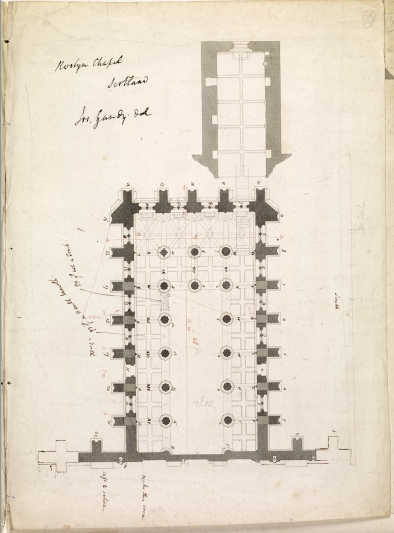Veronica Fraser, Archives Acquisitions and Loans Manager, writes: This volume came to light during research for the Rosslyn exhibition at the National Gallery of Scotland in 2002, and was subsequently the subject of an article by Angelo Maggi ‘Documents Relating to Roslin Chapel: a recently discovered collection of papers by John Britton’, published in Architectural Heritage XIII, 2002.
Rosslyn Chapel, Midlothian, is a collegiate church established by William Sinclair, the 3rd Earl of Orkney, around 1450. It is unique in Scotland for the wealth of its carved decoration; it is encrusted in Late Gothic foliage types and naïve secular and religious figures, creating a beautiful and mysterious interior which has inspired architects, writers and artists, and given rise to speculation on its associations, including the Holy Grail. Wordsworth wrote about the chapel and it featured in Sir Walter Scott’s epic poem, The Lay of the Last Minstrel, describing its ‘every pillar foliage bound’ and ‘every rose-carved buttress’.
The volume entitled ‘Documents Relating to Roslin Chapel’ comprises papers presumably collected by John Britton, the architectural publisher and antiquarian (1771-1857). It has 57 leaves and features drawings, engravings and letters collected by and sent to Britton. He had commissioned plates of the chapel for The Architectural Antiquities of Great Britain in 1812, and had also given a lecture on it to the Royal Institute of British Architects in January 1846. The contents of the album relate firstly to the creation of the illustrations for the published volume, and secondly to a debate regarding the restoration and history of the chapel.
For The Architectural Antiquities of Great Britain, Britton invited the draughtsman and architect Joseph Gandy (1771-1843) to draw plates of Rosslyn Chapel. Gandy travelled from London to Scotland in September 1806; the album features 12 of the drawings made at that time in order to execute the finished illustrations in Britton’s volume. Though not all of the drawings present lead to published illustrations, the drawings and a sketchbook in the Sir John Soane Museum, demonstrate how Gandy worked in the field to acquire the information for finished illustrations. The chapel’s architecture and atmosphere also inspired Gandy’s watercolour, Tomb of Merlin (1815).
The contents of the album also document contemporary thoughts regarding the restoration and history of the chapel. The 3rd Earl of Rosslyn carried out a restoration of the chapel, which had fallen into disrepair; he employed the architect William Burn (1789-1870) between 1837 and the mid 1840s. However, the changes to the appearance of the chapel, and perceived issues with the building process, angered the artist David Roberts, for whom the chapel and its setting were a great source of inspiration. Britton’s lecture in 1846 proved a catalyst for Roberts’ views, correspondence and illustrations in the album demonstrate their subsequent debate regarding the chapel’s history and archaeology. The album includes the evidence compiled by Britton from his circle of correspondents, including Sir Walter Scott (1771-1832) and the architect of the Scott Monument in Edinburgh, George Meikle Kemp (1789-1844).
HES is delighted to be able to make this wealth of information available to researchers and is grateful to the Rosslyn Chapel Trust for advice at the time of purchase.

